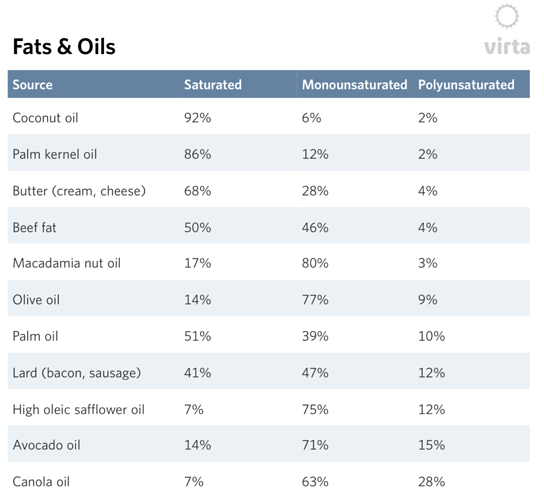I an investigating my chronic diarrhea (from even before keto) and I am looking for data that shows what percentage of different oils and foods have medium vs long chain fatty acids and other details. I have done an elimination diet and found out that I can eat unlimited coconut oil but any butter or bacon or avocado oil and I have immediate or delayed diarrhea. I’m trying to determine what is the exact differences so I can get down to what is the trigger in the foods. Links to resources where I can find the details would be appreciated. I have done several internet searches but I am unable to locate any. Thanks is advance.
Where can I see the percentages medium chain vs long chain fats in different foods
This article shows the MCT and lauric acid content of foods highest in capra acids. Hope it helps:
Wanted to mention what is recommended below seems almost as if it is the exact opposite with you or too much saturated fats and not enough monounsaturated fats? Hmmmm? Or maybe it is the protein intake %?
2. Are you eating low carb, LOW FAT, and high protein? Too much protein can lead to diarrhea.
Remember, a well-formulated ketogenic diet is low carb, high fat, and moderate protein. When cutting carbs, it can be tempting to increase your protein without increasing your fat, but the resulting high protein diet can lead to diarrhea (Speth, 1983). It is important to keep protein at about 10-20% of your daily energy need[1] and add ‘good fat’ for satiety[1]. More on what constitutes ‘good fats’ below. Read more on how much protein you need on a ketogenic diet
Are you choosing the right sources of dietary fat? Some oils can cause diarrhea:
While a little bit of omega-6 and omega-3 essential fats are required from our diet, more is not better. In particular, our digestive systems have a limited tolerance for vegetable and seed oils high in omega-6 fats. Early in our human research, we found out that feeding our patients a high fat diet made with soybean, corn, safflower, or sunflower oils promptly made them feel nauseated and caused diarrhea. Given that a well-formulated ketogenic diet eaten to maintain body weight provides 70-80%[1] of one’s daily energy[1] intake as fat[1], the majority of this fat intake needs to come from MONO-UNSATURATED and SATURATED sources such as olive oil, high oliec versions of safflower and sunflower, coconut oil, lard, butter, cream, and high fat cheese. …More
Here are some fats and oils that we recommend:
Footnotes:
Looks like you can look up the breakdown of fats at the USDA https://ndb.nal.usda.gov/ndb/foods/show/01001?n1={Qv%3D1}&fgcd=&man=&lfacet=&count=&max=25&sort=default&qlookup=butter&offset=&format=Full&new=&measureby=&Qv=1&ds=SR&qt=&qp=&qa=&qn=&q=&ing=#id-15
Here is a website where you can compare multiple foods down to the individual fats so you can compare medium vs long etc. https://tools.myfooddata.com/nutrition-comparison.php?foods=4047-1001-1132-23172-5746&serv=100g-100g-100g-100g-100g&qty=1-1-1-1-1

